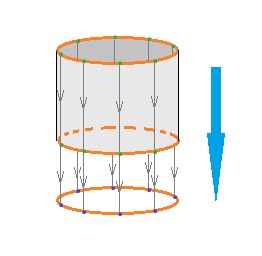This site is being phased out.
Vietoris Mapping Theorem
Redirect to:
Let's compare the homology maps of these two projections.
- The projection of the cylinder
$$P \colon {\bf C}^2 = [0,1] \times {\bf S}^1 \rightarrow {\bf S}^1$$ on the circle:
- Projection of torus
$$Q \colon {\bf T}^2 = {\bf S}^1\times {\bf S}^1 \rightarrow {\bf S}^1$$ on the circle:
The homology map of the first $$P_* \colon H_1({\bf C}^2)={\bf R} \rightarrow H_1({\bf S}^1)={\bf R}$$ is an isomorphism and that of the second $$Q_* \colon H_1({\bf T}^2)={\bf R}^2 \rightarrow H_1({\bf S}^1)={\bf R}$$ is another projection.
Why the difference?
Clearly, $Q$ collapses the other circle and, as one would expect, $Q_*$ "kills" its homology class. The effect of $P$ on the homology of the cylinder is nil.
Now, can we predict this without computing the homology maps?
The answer is yes. All we have to look at is the preimages of points (fibers) of the two maps.
- For $P$, the preimages are segments. Therefore they are homologically trivial.
- For $Q$, they are circles and, therefore, not homologically trivial.
We call "homologically trivial" spaces acyclic:
- $\tilde H_r(A) = 0,$ for all $0\leq r\leq n-1$,
where $\tilde H_r$ is the reduced homology group.
Vietoris Mapping Theorem. Let $X$ and $Y$ be cell complexes, and let $f:X \rightarrow Y$ be a surjective cell map. Suppose that the fibers of $f$ are acyclic. Then, the induced homomorphism $$f_*:\tilde H_r(X)\to\tilde H_r(Y)$$ is an isomorphism for $r\leq n-1$ and a surjection for $r=n$.
The ability to "reverse" $f_*$ comes handy when one studies set-valued maps.
Proof.

